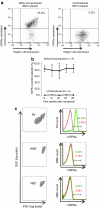Correction of murine Bernard-Soulier syndrome by lentivirus-mediated gene therapy
- PMID: 22044935
- PMCID: PMC3293608
- DOI: 10.1038/mt.2011.231
Correction of murine Bernard-Soulier syndrome by lentivirus-mediated gene therapy
Abstract
Bernard-Soulier syndrome (BSS) is an inherited bleeding disorder caused by a defect in the platelet glycoprotein (GP) Ib-IX-V complex. The main treatment for BSS is platelet transfusion but it is often limited to severe bleeding episodes or surgical interventions due to the risk of alloimmunization. We have previously reported successful expression of human GPIbα (hGPIbα) in human megakaryocytes using a lentiviral vector (LV) encoding human GP1BA under control of the platelet-specific integrin αIIb promoter (2bIbα). In this study, we examined the efficacy of this strategy for the gene therapy of BSS using GPIbα(null) as a murine model of BSS. GPIbα(null) hematopoietic stem cells (HSC) transduced with 2bIbα LV were transplanted into lethally irradiated GPIbα(null) littermates. Therapeutic levels of hGPIbα expression were achieved that corrected the tail bleeding time and improved the macrothrombocytopenia. Sequential bone marrow (BM) transplants showed sustained expression of hGPIbα with similar phenotypic correction. Antibody response to hGPIbα was documented in 1 of 17 total recipient mice but was tolerated without any further treatment. These results demonstrate that lentivirus-mediated gene transfer can provide sustained phenotypic correction of murine BSS, indicating that this approach may be a promising strategy for gene therapy of BSS patients.
Figures






Similar articles
-
Non-myeloablative conditioning with busulfan before hematopoietic stem cell transplantation leads to phenotypic correction of murine Bernard-Soulier syndrome.J Thromb Haemost. 2014 Oct;12(10):1726-32. doi: 10.1111/jth.12673. Epub 2014 Aug 26. J Thromb Haemost. 2014. PMID: 25066812 Free PMC article.
-
Lentiviral gene rescue of a Bernard-Soulier mouse model to study platelet glycoprotein Ibβ function.J Thromb Haemost. 2016 Jul;14(7):1470-9. doi: 10.1111/jth.13355. Epub 2016 Jul 14. J Thromb Haemost. 2016. PMID: 27148783
-
Study of Bernard-Soulier Syndrome Megakaryocytes and Platelets Using Patient-Derived Induced Pluripotent Stem Cells.Thromb Haemost. 2019 Sep;119(9):1461-1470. doi: 10.1055/s-0039-1693409. Epub 2019 Jul 28. Thromb Haemost. 2019. PMID: 31352676
-
Bernard-Soulier syndrome: an update.Semin Thromb Hemost. 2013 Sep;39(6):656-62. doi: 10.1055/s-0033-1353390. Epub 2013 Aug 8. Semin Thromb Hemost. 2013. PMID: 23929303 Review.
-
Genetic abnormalities of Bernard-Soulier syndrome.Int J Hematol. 2002 Nov;76(4):319-27. doi: 10.1007/BF02982690. Int J Hematol. 2002. PMID: 12463594 Review.
Cited by
-
Transfusion of Platelets Loaded With Recombinant ADAMTS13 (A Disintegrin and Metalloprotease With Thrombospondin Type 1 Repeats-13) Is Efficacious for Inhibiting Arterial Thrombosis Associated With Thrombotic Thrombocytopenic Purpura.Arterioscler Thromb Vasc Biol. 2018 Nov;38(11):2731-2743. doi: 10.1161/ATVBAHA.118.311407. Arterioscler Thromb Vasc Biol. 2018. PMID: 30354235 Free PMC article.
-
The impact of GPIbα on platelet-targeted FVIII gene therapy in hemophilia A mice with pre-existing anti-FVIII immunity.J Thromb Haemost. 2019 Mar;17(3):449-459. doi: 10.1111/jth.14379. Epub 2019 Feb 3. J Thromb Haemost. 2019. PMID: 30609275 Free PMC article.
-
Lentiviral gene therapy reverts GPIX expression and phenotype in Bernard-Soulier syndrome type C.Mol Ther Nucleic Acids. 2023 Jun 12;33:75-92. doi: 10.1016/j.omtn.2023.06.008. eCollection 2023 Sep 12. Mol Ther Nucleic Acids. 2023. PMID: 37416759 Free PMC article.
-
Learning the Ropes of Platelet Count Regulation: Inherited Thrombocytopenias.J Clin Med. 2021 Feb 2;10(3):533. doi: 10.3390/jcm10030533. J Clin Med. 2021. PMID: 33540538 Free PMC article. Review.
-
The impact of aberrant von Willebrand factor-GPIbα interaction on megakaryopoiesis and platelets in humanized type 2B von Willebrand disease model mouse.Haematologica. 2022 Sep 1;107(9):2133-2143. doi: 10.3324/haematol.2021.280561. Haematologica. 2022. PMID: 35142156 Free PMC article.
References
-
- Bernard J., and, Soulier JP. [Not Available] Sem Hop. 1948;24 Spec. No.:3217–3223. - PubMed
-
- Nurden P., and, Nurden AT. Congenital disorders associated with platelet dysfunctions. Thromb Haemost. 2008;99:253–263. - PubMed
-
- Clemetson KJ, McGregor JL, James E, Dechavanne M., and, Lüscher EF. Characterization of the platelet membrane glycoprotein abnormalities in Bernard-Soulier syndrome and comparison with normal by surface-labeling techniques and high-resolution two-dimensional gel electrophoresis. J Clin Invest. 1982;70:304–311. - PMC - PubMed
-
- López JA, Andrews RK, Afshar-Kharghan V., and, Berndt MC. Bernard-Soulier syndrome. Blood. 1998;91:4397–4418. - PubMed
Publication types
MeSH terms
Substances
Grants and funding
LinkOut - more resources
Full Text Sources
Other Literature Sources
Medical
Miscellaneous

